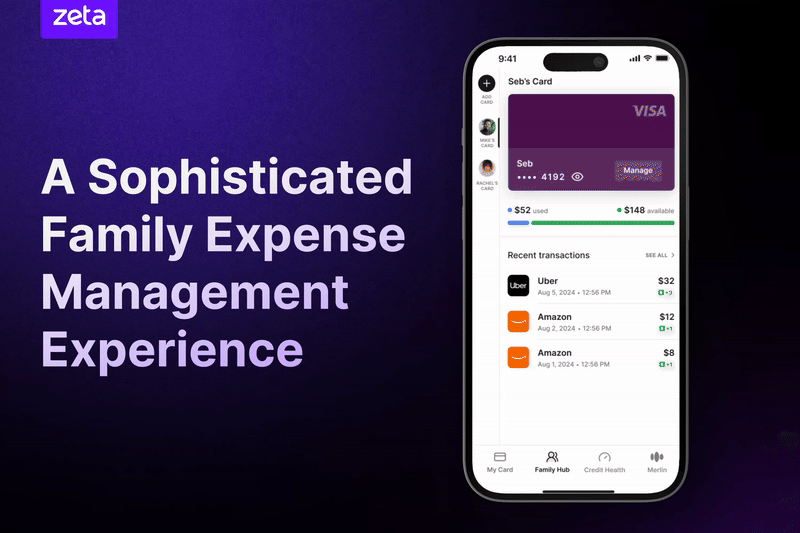Family Hub Card Programs: The Next Growth Engine for Credit Unions

Contents
- Why Credit Unions Need a Firmer Hold on Gen Zs
- Why Family Hub Card Programs Can Be a Growth Engine for Credit Unions
- How Credit Unions Can Deliver a Winning Family Hub Card Program
- Thriving with Next-Gen Solutions
With a significant portion of their member base aging, credit unions (CUs) are under mounting pressure to attract and engage younger generations. Results from a Keypoint Intelligence survey of over 1,100 Americans show that only 5% of millennials and 4% of Gen Zs are CU members1, presenting a substantial opportunity for credit unions.
The children of current members are a key source of growth for credit unions, allowing them to attract the next generation. However, retaining this young demographic hinges on the ability of credit unions to offer the digitally sophisticated products that Gen Z demands. In fact, data shows Gen Zs are 2.5 times more likely than older generations to switch from financial institutions that don’t innovate2. Currently, McKinsey reports that only 49% of Gen Z members believe that their credit union offers excellent value in areas such as customer service, community support, and digital banking3.
This blog will explore why credit unions must strengthen their connection with Gen Z, the revenue potential of engaging this demographic, and the role of targeted family programs as a growth engine. Additionally, we will delve into effective strategies for credit unions to implement these approaches successfully, ensuring sustainable growth and profitability.
Why Credit Unions Need a Firmer Hold on Gen Zs
The majority of CU members are nearing retirement age, leading to a decrease in loan demand and a shift towards lower-yield deposit accounts. The typical credit union member is in their mid-50s, with approximately 75% of credit union deposits coming from this older demographic4.
The older demographic is more likely to have paid off their mortgages and carry lower credit card balances, resulting in reduced revenue opportunities for CUs. In contrast, younger demographics, who are more inclined to seek loans and other financial products, present higher revenue potential.
Gen Z is embracing credit cards at an unprecedented rate. By 2023, a whopping 84% of credit-active Gen Z consumers held at least one card, outpacing even the tech-savvy millennials5.
Why Family Hub Card Programs Can Be a Growth Engine for Credit Unions
Thirty-five percent of Gen Zs are still students; however, research from Bank of America shows that 46% are still financially dependent on their parents.
According to a PwC survey, initiatives targeting existing customers can yield over a 70% return, significantly reducing customer acquisition expenses. By introducing family-based card programs, what we refer to as family hubs, credit unions can take ownership of teens’ and kids’ spending and transaction data. This not only further lowers acquisition costs, but also positions CUs to leverage AI for analyzing this data, enabling hyper-personalized offerings.
By reimagining family banking for the digital age, forward-thinking institutions can create lasting connections with their members’ children long before they’re ready for their first solo account.
Demand for Family Hub Card Programs
Family hub card programs can provide parents with peace of mind while gradually introducing their children to financial independence. Parents appreciate the ability to extend banking services to their children while maintaining control through features like geofencing and spending limits.
Family-focused neobanks like Greenlight and GoHenry have seen tremendous success in recent years, with Greenlight reporting over 5 million users as of 20236. With growth driven by the increasing demand for digital financial education tools and child-friendly banking services, these neobanks have demonstrated that there is a substantial market for products that cater to both parents and children, providing CUs with a roadmap for success in this space.
How Credit Unions Can Deliver a Winning Family Hub Card Program
Cards as a Logical Starting Point
Neobanks like Greenlight have shown that introducing prepaid cards for children is an effective entry point for engaging younger customers. These cards offer parents control over spending while giving children a taste of financial independence. By adopting a similar strategy, CUs can attract families by offering secure, easy-to-use financial products that grow with the child, transitioning from prepaid cards to full-fledged accounts as they mature.
Family Hub: The Next Differentiator
A sophisticated family expense management program can serve as a key differentiator.
Comprehensive controls enable the primary cardholder to fine-tune where and when the add-on cards are used, including the ability to set time of usage, whitelist/blacklist merchants, create categories, set spend limits, geo-fencing, and more. Such a program not only appeals to parents, but also educates children on responsible financial behavior from an early age.
Zero Friction
For a family hub card program to succeed, it must offer zero friction in onboarding and usage. This includes instant onboarding of family members and the instant issuance of virtual cards for immediate use. By reducing barriers to entry and simplifying the user experience, CUs can encourage wider adoption of their family programs.
Importance of Control, Transparency, and Security
In today’s digital age, control, transparency, and security are paramount. CUs should offer digital controls, comprehensive & enriched transaction statements, real-time spend notifications and analytics, and dynamic CVV/PIN for enhanced security.
These features provide parents with peace of mind while ensuring that children learn about money management in a safe environment.
Here’s an example of how parents can control and monitor their children’s spends digitally:

Importance of Encouraging Better Financial Behavior
Family hub card programs also focus on encouraging better financial behavior among young members. Features like regularly refreshed credit scores, personalized credit journeys, hyper-personalized offers and rewards, and subscription management can help guide children and teenagers toward responsible financial habits.
Thriving with Next-Gen Solutions
In conclusion, the future of credit unions lies in their ability to engage younger generations through innovative, digital-first family hub card programs. And with the new breed of cloud-native, modular card issuance and processing platforms, launching a market-leading family hub card program for digital-native Gen Zs without a multi-year transformation program is very much possible.
By leveraging these advanced platforms, credit unions can not only meet the immediate needs of Gen Z, but also build a foundation for long-term member loyalty. This approach ensures that credit unions remain relevant in an increasingly competitive financial landscape. Ultimately, embracing family-centric strategies could be the key to unlocking sustained growth and securing a vibrant future for credit unions.
References:
- Keypoint Intelligence, What Do Younger Consumers Look for in a Financial Services Provider? | April 2023
- PYMNTS, Why Gen Z Can Be Credit Unions Best Friend or Worst Enemy | May 2024
- McKinsey & Company, Six imperatives for credit unions to secure their future | June 2024
- Credit Unions, The Buzz Explained: How Credit Unions Are Set To Triple Deposits In 2024 | April 2024
- TransUnion, Gen Z Consumers Are Using Credit More, and Differently, than Their Millennial Counterparts at the Beginning of their Credit Journeys | May 2024
- Greenlight, Homepage | 2023



